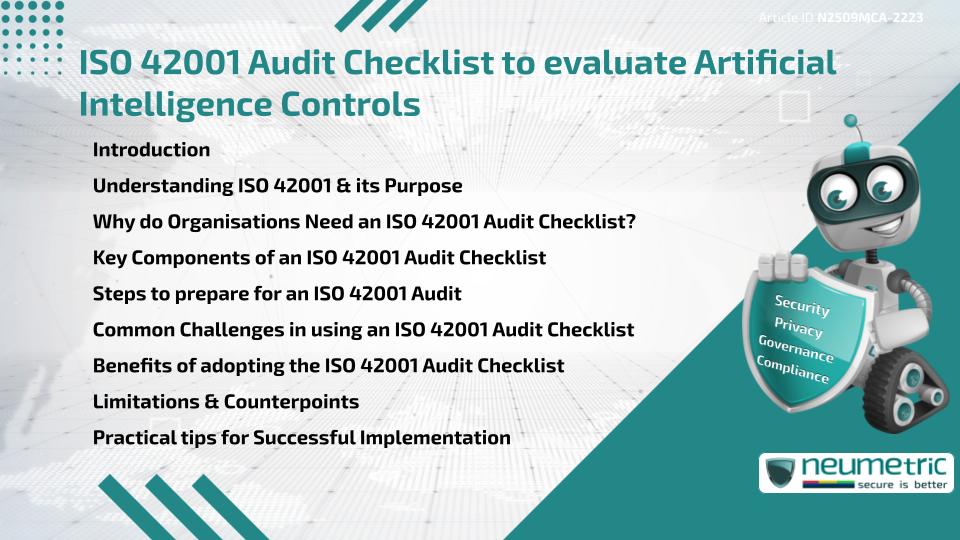Table of Contents
ToggleIntroduction
The ISO 42001 Audit Checklist is a vital tool for evaluating Artificial Intelligence Controls within Organisations. It helps businesses assess Compliance, identify Risks & ensure Ethical use of Artificial Intelligence technologies. By following this structured approach, Organisations can measure their readiness against the International organisation for Standardisation [ISO] Framework for Artificial Intelligence management. The Audit Checklist highlights essential areas such as Governance, Transparency, Accountability, Data Handling & Continuous Improvement. For Organisations adopting Artificial Intelligence, using an ISO 42001 Audit Checklist not only improves Regulatory Compliance but also builds Stakeholder trust.
Understanding ISO 42001 & its Purpose
ISO 42001 is a Standard designed to guide Organisations in establishing effective Artificial Intelligence management systems. Much like ISO 27001 for Information Security or ISO 9001 for quality, ISO 42001 provides a structured Framework. It focuses on reducing Risks, ensuring Transparency & Safeguarding data. The ISO 42001 Audit Checklist aligns with this Standard by converting abstract requirements into practical evaluation points.
Why do Organisations Need an ISO 42001 Audit Checklist?
Artificial Intelligence systems are complex, often operating on data-driven models that may introduce bias or Compliance Risks. Without a clear Checklist, Audits may overlook key areas such as algorithmic fairness or data provenance. An ISO 42001 Audit Checklist ensures that Organisations evaluate critical aspects consistently.
It acts as a bridge between Policies & Practical actions, ensuring that Ethical principles are embedded into technology. For example, Auditors can use the Checklist to confirm if decision-making systems are explainable & if monitoring mechanisms are in place.
Key Components of an ISO 42001 Audit Checklist
An effective Checklist typically includes:
- Governance & leadership: Ensuring leadership is Accountable for Artificial Intelligence Controls.
- Risk Management: Identifying Risks across development, deployment & use stages.
- Transparency: Confirming that outputs are understandable to users.
- Data quality: Assessing how data is collected, stored & processed.
- Monitoring & improvement: Verifying continuous evaluation of Artificial Intelligence performance.
Steps to prepare for an ISO 42001 Audit
Preparation is crucial for success. Organisations should:
- Map Artificial Intelligence processes against the ISO 42001 Audit Checklist.
- Conduct Internal Gap Assessments to identify missing Controls.
- Train staff on responsibilities & expected practices.
- Collect documented Evidence for each requirement.
- Perform trial Audits before the official Assessment.
A structured preparation plan minimises Surprises & strengthens Compliance.
Common Challenges in using an ISO 42001 Audit Checklist
Even with a Checklist, Organisations may face challenges. Some common difficulties include:
- Lack of expertise in Artificial Intelligence Risk evaluation.
- Difficulty translating high-level principles into operational measures.
- Resistance from teams who see the Audit as an obstacle rather than a safeguard.
Acknowledging these challenges helps Organisations adopt practical strategies to overcome them.
Benefits of adopting the ISO 42001 Audit Checklist
Adopting the Checklist brings several benefits:
- Improves confidence in Artificial Intelligence systems.
- Demonstrates Compliance with regulatory & industry requirements.
- Promotes Transparency & Accountability.
- Strengthens Stakeholder trust & brand reputation.
- Encourages Continuous Monitoring & Improvement.
Limitations & Counterpoints
While helpful, the ISO 42001 Audit Checklist is not a substitute for expert judgment. Artificial Intelligence systems evolve rapidly & no Checklist can cover every emerging Risk. Over-reliance on the document may lead to a “tick-box” approach instead of fostering a culture of responsibility.
Practical tips for Successful Implementation
- Involve cross-functional teams including Legal, Technical & Ethical experts.
- Update the Checklist regularly to match changes in Artificial Intelligence systems.
- Use it alongside other frameworks such as ISO 27001 or GDPR Compliance.
- Encourage open communication about Audit Findings to build Trust.
Takeaways
- The ISO 42001 Audit Checklist helps evaluate Artificial Intelligence Controls systematically.
- It supports Compliance, Risk Management & Ethical Governance.
- The checklist builds Transparency & Trust with Stakeholders.
- It should complement expert judgment & not replace it.
- Regular updates & cross-functional input ensure its effectiveness.
FAQ
What is the ISO 42001 Audit Checklist?
It is a structured guide to evaluate Artificial Intelligence Controls & Compliance with ISO 42001 requirements.
How does the ISO 42001 Audit Checklist benefit Organisations?
It helps Organisations manage Risks, ensure Transparency & build Trust in Artificial Intelligence systems.
Is the ISO 42001 Audit Checklist mandatory for certification?
While not mandatory, it is a practical tool that simplifies Compliance with ISO 42001 standards.
Can Small Businesses use the ISO 42001 Audit Checklist?
Yes, the Checklist can be scaled to suit small, medium or large Organisations.
What areas does the ISO 42001 Audit Checklist cover?
It covers Governance, Risk Management, Transparency, Data handling & Monitoring.
How often should Organisations use the ISO 42001 Audit Checklist?
It should be used regularly, especially before internal or external Audits.
What challenges exist in applying the ISO 42001 Audit Checklist?
Challenges include lack of expertise, resistance from teams & difficulties in interpreting high-level principles.
Need help for Security, Privacy, Governance & VAPT?
Neumetric provides organisations the necessary help to achieve their Cybersecurity, Compliance, Governance, Privacy, Certifications & Pentesting needs.
Organisations & Businesses, specifically those which provide SaaS & AI Solutions in the Fintech, BFSI & other regulated sectors, usually need a Cybersecurity Partner for meeting & maintaining the ongoing Security & Privacy needs & requirements of their Enterprise Clients & Privacy conscious Customers.
SOC 2, ISO 27001, ISO 42001, NIST, HIPAA, HECVAT, EU GDPR are some of the Frameworks that are served by Fusion – a SaaS, multimodular, multitenant, centralised, automated, Cybersecurity & Compliance Management system.
Neumetric also provides Expert Services for technical security which covers VAPT for Web Applications, APIs, iOS & Android Mobile Apps, Security Testing for AWS & other Cloud Environments & Cloud Infrastructure & other similar scopes.
Reach out to us by Email or filling out the Contact Form…


